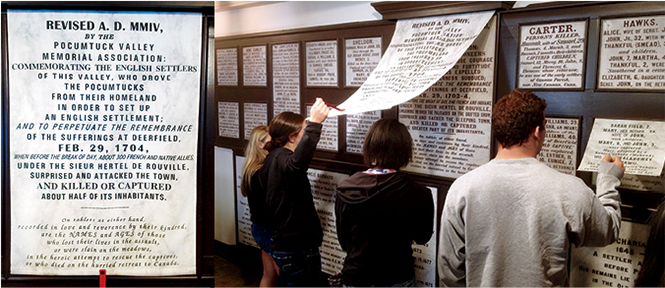“What would you do if you had to pick one thing to focus on in an introductory American studies course?” asks department chair Karen Sánchez-Eppler.
“We had a lot of success with our New York City course, which involved a field trip to New York. So we thought: How about if we did here?”
The result is “Global Valley,” taught last fall by professors Sánchez-Eppler and Lisa Brooks. It covers the history and culture of sites barely a half-hour drive from campus, starting with an overview of the geology, flora and fauna of the region and jumping into early European settlement and interactions with Native Americans.
One field trip took students to Deerfield, Mass., to learn about the 1704 raid on the settlement and changing perspectives on the Deerfield Massacre. Among their stops, students visited a museum that has covered up old memorial plaques with modern interpretations of them. For example, one plaque reads: Mary, adopted by an Indian, was named Walahowey. She married a savage, and became one. It’s now covered with a cloth that says: She married a Kanien’kehaka and adopted the culture, customs and language of her new community in Kahnawake.

In Deerfield, Mass., to learn about the 1704 raid on the settlement, students visited a museum that has covered old memorials with modern interpretations of them. Later, the course focused on other benchmarks in local history: the Great Awakening in Northampton, Shays’ Rebellion, Sojourner Truth’s time in Florence, Mass., and the industrial revolution. Photos by William Sweet
Students also read the public responses—including death threats—that erupted when the museum made these additions.
“When the history of English settlement is discussed, the Native perspective is often left out of the picture,” says Christopher Tamasi ’15, who took the course last semester. “We embraced all historical accounts, which allowed students to formulate their own opinions.”
As the semester went on, students took to the streets of Holyoke to study the Industrial Revolution and waves of immigration. They retraced the steps of past census-takers to see how the city changed over the years with the rise and fall of its paper mills.